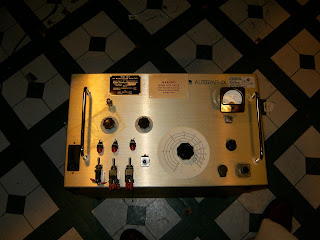


Now that all of the RF modules are complete it is time to machine out a chassis.
I found an old 'Autographics' computer chassis at a hamfest for $5. It is made out of aluminum which is easy to machine. The front panel is mostly blank, except for a few holes for a D connector and some BNC's.
Radio design is an art for and this chassis will be the perfect canvas for this homebrew 20 M ssb transceiver.
From bottom to top:
->front-panel controls sitting on the chassis used to decide on a final layout
->drill holes measured and drawn on the front of the chassis using 0.5 mm pencil
->front panel after machining (using my drill press)
